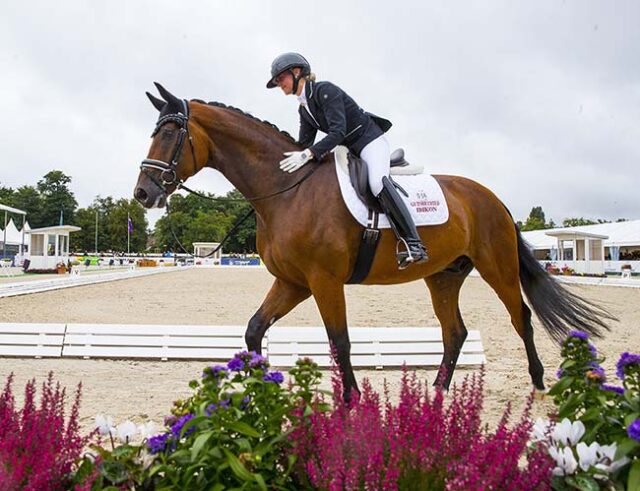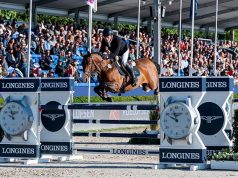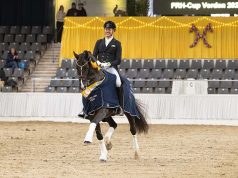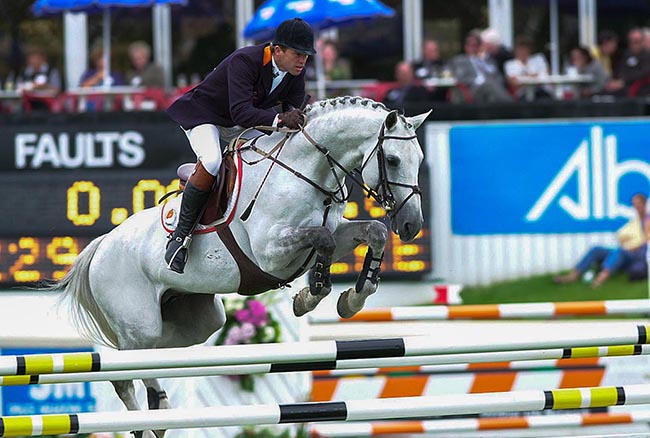By Christopher Hector
Photography: FEI/de Koster
Frankfurt's Nürnberger Berg-Pokal is a vital cog in the sophisticated process that leaves Germany in the forefront when it comes to producing Grand Prix horses. But this gentle introduction to FEI classes is also a window on the German breeding scene; just which stallions are producing progeny that go on to the big sport?
Most of the currently fashionable stallions are represented in Frankfurt, but there is one surprise and that is the only stallion with more than one finalist – DiMaggio.
Ridden by his owner, British rider Suzanne Davies, DiMaggio was the winner of the very first World Breeding Championship for Young Horses in 2000 in Arnhem. He was trained to small tour before laminitis ended his competition career. He was a popular stallion in Britain but only really showed his worth when he transferred to Gestüt Vorwerk in the last 2000s and before moving on to the Böckmann stallion station. DiMaggio was the product of two of the pioneers of dressage breeding.
His sire, Don Primero, was the first stallion star by Donnerhall. Don Primero was the champion five-year-old dressage horse at the 1990 Bundeschampionate and went on to compete at Grand Prix level with Karin Rehbein. He is a full blood brother to the more famous stallion and Grand Prix performer, Don Schufro (whose dam Fiesta is a full sister to Don Primero's dam Fantasia).
For a number of years Don Primero headed both the Hanoverian and FN dressage stallion rankings although, perhaps partly because he was based in Sweden for much of his career, he slipped down the list, and he appears in the 2010 Hanoverian Stallion book, for the last time.
As of 2010, Don Primero has produced 438 registered competition horses with winnings of €537,763 – 385 in dressage (75 to advanced). His most successful progeny were Karin Rehbein’s WBCYH champion, Cherie (€36,666) and Dow Jones with €26,834. Seven of his competitors won more than €10,000.
Dimaggio’s damsire, World Cup I, was another of the key players in the emergence of the modern dressage horse spreading the influence of his sire Woermann without his dodgy temperament. The first public appearance of the two-and-a-half-year-old Woermann at the Hanoverian licensing in 1973 in Verden signalled a total turn around in Warmblood breeding. Woermann was the new measuring-stick for type, riding-oriented outline, and construction, but particularly in movement – his elastic, rhythmic and elevated trot were previously unseen. These impressions were confirmed in the 1973 stallion performance test. As expected, Woermann passed with flying colours, and the final report certifies: ‘energetic temperament, sufficient durability, very good rideability, jumping ability of good average, very good walk, outstanding trot, good canter – a very talented riding horse, most suitable for dressage.’ Which was timely since just about then the sport of dressage was growing in importance and prestige and breeders were now looking to breed for that market.
However, although there was a feeling that Woermann could produce horses with a slightly difficult temperament, very few of them became top competitors, and it was his most famous son, World Cup I, whose temperament was far more civilised, who really played a crucial role in the development of the modern dressage horse. World Cup was crowned Hanoverian stallion of the year 1996. His most famous product was Isabell Werth’s Grand Prix dressage horse Welcome who was sold to the Netherlands. He produced 16 licensed stallions, five of whom stood at Celle: Weltmeyer, Walt Disney, Warkant, Wogenspieler, and Woodstock... To read the complete article you need to be a subscriber
CLICK HERE TO SUBSCRIBE TO BREEDING NEWS
SUBSCRIBERS CAN READ THE COMPLETE ARTICLE BY LOGGING IN AND RETURNING TO THIS PAGE




